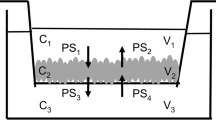Abstract
Purpose
Recently, it was reported that the apparent Michaelis-Menten constant (Km(app)) of a P-glycoprotein (P-gp) substrate, defined for the extracellular substrate concentration, increases as the P-gp expression level in the cell increases. By its nature, the Km value should not depend on the level of P-gp expression. The purpose of this study is to establish a model which can estimate the Km value independent of the P-gp expression level in cells.
Methods
The previously reported concentration-dependent permeability of verapamil, quinidine, and vinblastine in MDR1-MDCKII, P-gp-highly induced Caco-2, P-gp-induced Caco-2, normal Caco-2, and MDR1-knockdown Caco-2 cells data were analyzed using a model in which the Km value was defined for the intracellular substrate concentration.
Results
The estimated Km values defined for the substrate concentration inside the cells were almost the same among various cells with different levels of P-gp expression. The estimated Vmax values were approximately proportional to the P-gp expression level.
Conclusion
The established kinetic model was found to be rational based on the results that the Km values of P-gp substrates were about the same for cells expressing various levels of P-gp, while the Vmax values were proportional to the expression levels of P-gp.




Similar content being viewed by others
REFERENCES
Mizuno N, Niwa T, Yotsumoto Y, Sugiyama Y. Impact of drug transporter studies on drug discovery and development. Pharmacol Rev. 2003;55:425–61.
Fromm MF. Importance of P-glycoprotein for drug disposition in humans. Eur J Clin Invest. 2003;33 Suppl 2:6–9.
Fromm MF. Importance of P-glycoprotein at blood-tissue barriers. Trends Pharmacol Sci. 2004;25:423–9.
Brinkmann U. Functional polymorphisms of the human multidrug resistance (MDR1) gene: correlation with P glycoprotein expression and activity in vivo. Novartis Found Symp. 2002;243:207–10. discussion 210-2, 231-5.
Fromm MF. P-glycoprotein: a defense mechanism limiting oral bioavailability and CNS accumulation of drugs. Int J Clin Pharmacol Ther. 2000;38:69–74.
Zhang Y, Benet LZ. The gut as a barrier to drug absorption: combined role of cytochrome P450 3A and P-glycoprotein. Clin Pharmacokinet. 2001;40:159–68.
Woo JS, Lee CH, Shim CK, Hwang SJ. Enhanced oral bioavailability of paclitaxel by coadministration of the P-glycoprotein inhibitor KR30031. Pharm Res. 2003;20:24–30.
Martin-Facklam M, Burhenne J, Ding R, Fricker R, Mikus G, Walter-Sack I, et al. Dose-dependent increase of saquinavir bioavailability by the pharmaceutic aid cremophor EL. Br J Clin Pharmacol. 2002;53:576–81.
Wetterich U, Spahn-Langguth H, Mutschler E, Terhaag B, Rosch W, Langguth P. Evidence for intestinal secretion as an additional clearance pathway of talinolol enantiomers: concentration- and dose-dependent absorption in vitro and in vivo. Pharm Res. 1996;13:514–22.
Regardh CG, Heggelund A, Kylberg-Hanssen K, Lundborg P. Pharmacokinetics of pafenolol after i.v. and oral administration of three separate doses of different strength to man. Biopharm Drug Dispos. 1990;11:607–17.
Caruso FS, Doshan HD, Hernandez PH, Costello R, Applin W, Neiss ES. Celiprolol: pharmacokinetics and duration of pharmacodynamic activity. Br J Clin Pract Suppl. 1985;40:12–6.
Shirasaka Y, Sakane T, Yamashita S. Effect of P-glycoprotein expression levels on the concentration-dependent permeability of drugs to the cell membrane. J Pharm Sci. 2008;97:553–65.
Korjamo T, Kemilainen H, Heikkinen AT, Monkkonen J. Decrease in intracellular concentration causes the shift in Km value of efflux pump substrates. Drug Metab Dispos. 2007;35:1574–9.
Tang F, Horie K, Borchardt RT. Are MDCK cells transfected with the human MDR1 gene a good model of the human intestinal mucosa? Pharm Res. 2002;19:765–72.
Shirasaka Y, Masaoka Y, Kataoka M, Sakuma S, Yamashita S. Scaling of in vitro membrane permeability to predict P-glycoprotein-mediated drug absorption in vivo. Drug Metab Dispos. 2008;36:916–22.
Author information
Authors and Affiliations
Corresponding author
Rights and permissions
About this article
Cite this article
Tachibana, T., Kitamura, S., Kato, M. et al. Model Analysis of the Concentration-Dependent Permeability of P-gp Substrates. Pharm Res 27, 442–446 (2010). https://doi.org/10.1007/s11095-009-0026-9
Received:
Accepted:
Published:
Issue Date:
DOI: https://doi.org/10.1007/s11095-009-0026-9




